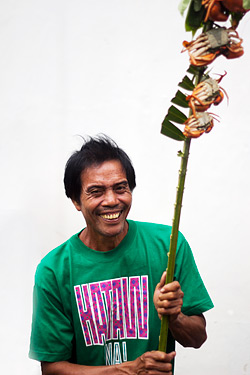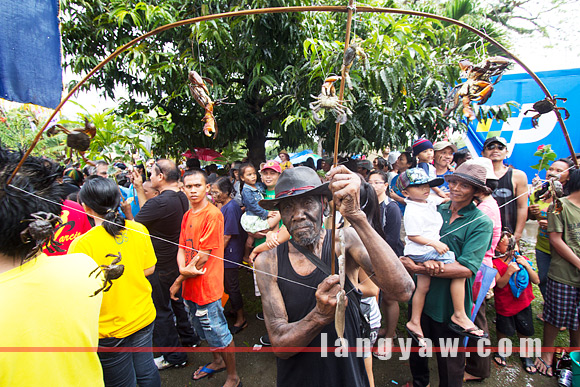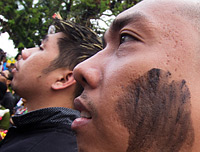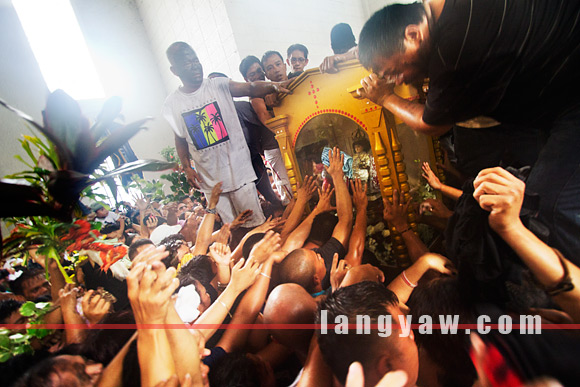
It was rather weird. Something that struck me as unusual that caught me off guard. People were holding skewered and grilled chicken or parts of it. Some with steamed crabs dangling from sticks. Whole fish tied to another and, even strange, raw meat stuck to a man’s body or raised up on wooden sticks, waved and being agitated to the loud shouts of Viva! Senor Sto. Nino!

A few meters away, beautifully clad gay men in fairy costumes were holding icons of the Sto. Nino, posing from time to time for amused people. But another lady was walking to the church with a nude baby doll strapped to her front.
In the first place, it was a Catholic celebration in Ibajay, one of the municipalities of Aklan that marks the 4th Sunday of January as the feast of the Sto. Nino, the Holy Child that is quite popular in the Philippines.
Second, people say that the Ati-ati celebration is more authentic. Third, hinting from the Ati-ati (from the word Ati, referring to the nomadic indigenous group who are short, dark skinned and got curly hair), I wasn’t just prepared for the ritualistic part that may have paganistic roots syncretized into Catholicism. People say that the food, both raw or cooked, is an offering to the Sto. Nino.


The town is just one of a series of municipalities in the northwestern part of the province that celebrates the Ati-atihan. Foremost is the one in Kalibo, held every 3rd Sunday of January and now, allegedly, into its 800th plus year. Makato is another town with an ati-atihan event, every 15th of January while Boracay, every 2nd Sunday of the same month.
But in Ibajay, people just get into the mood. The feast is a given and both young and old soot themselves black and gather either outside the convent beside the church or inside the latter to await the short procession of the image.

If you’re clean, even a visitor, you won’t be spared and people will place soot on your face, in the spirit of fun, of course! It’s even normal to see both men and women holding bottles of beer before, during or after the procession, even at church! Drunkards also abound.
 There’s more to the western part of Panay than Boracay. In fact, there are many interesting places in the provinces of Aklan, Antique and western Iloilo that just amazes without driving all the way to Caticlan. Ruins, churches, food and rowdy festivals are there waiting. Here, everyone just go with the beat of drums, and not just by one group, but two, three, five or even seven drum corps inside the church trying to outdo each other in loudness! And it can be DEAFENINGLY LOUD! As the clock approaches 11 AM, the drums get louder and louder as people start to get excited.
There’s more to the western part of Panay than Boracay. In fact, there are many interesting places in the provinces of Aklan, Antique and western Iloilo that just amazes without driving all the way to Caticlan. Ruins, churches, food and rowdy festivals are there waiting. Here, everyone just go with the beat of drums, and not just by one group, but two, three, five or even seven drum corps inside the church trying to outdo each other in loudness! And it can be DEAFENINGLY LOUD! As the clock approaches 11 AM, the drums get louder and louder as people start to get excited.


As the image of the Sto. Nino is transported outside of the convento and into the church, just a few meters distance, the crowd start to be agitated.
The sticks, palms and branches either laden with seafood, grilled chicken, raw meat or even, succulent crispy pata is swung from side to side. People shout Viva! Sto. Nino and the pushing and pulling starts as the image passes.
Once inside, the drumbeats gets even louder and people are trying to go in one direction: to the image at the center of the presbytery to touch it.


The Ibajay Sto. Nino festivities is small compared to the one in Cebu, but the ardent fervor of the devotees coupled with the seeming paganistic/ritualistic practices makes it unique.
After this event, which falls on a Saturday, Sunday morning is the Ati-ati Festival and at around 3 PM, people again gather at the church and lead the image via a short procession back to the convent.
Ang Langyaw’s Panay Island trip courtesy of Airphilexpress, the fastest growing budget airline in the Philippines that made this trip possible!
The photos are filled with actions and natawa naman ako sa mga gay in fairy customes, hehe. indescribable nga. 🙂
Lupet bai! Super liked the photos as usual! Now ko lang alam to. Hehehe
ganda! tagal ko na din gustong mag ati atihan sa ibajay. hopefully next year….
its good there too enrico 🙂
next year dinagyang naman ako
thanx bai
Food for thought: I am a native of Ibajay but now based here in Los Angeles. We from Ibajay believed that the Ati-atihan started in Sitio Boboc-on in the barangay of Naile. When the ati-atihan evolved into a major religious event, people from the hinterlands had to walk for hours if not days not only to join the festivities but also to fulfill their vows of paying homage to the Holy Child. They have to bring provisions during this journey, thus the various kinds of food carried by the pilgrims during the procession. The waving of this food during the procession is the pilgrims’ way of imploring the divine child to bless this food to become their spiritual food. This food is gladly shared with those who don’t have after the mass. The fervor of the Ibajay Ati-atihan is not justified by it’s outside appearance. It is justified by strength of the pilgrims’ faith.